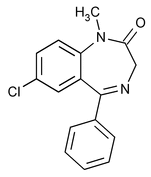Diazepam
(dye az' e pam).
2H-1,4-Benzodiazepin-2-one, 7-chloro-1,3-dihydro-1-methyl-5-phenyl-.
7-Chloro-1,3-dihydro-1-methyl-5-phenyl-2H-1,4-benzodiazepin-2-one
» Diazepam contains not less than 95.0 percent and not more than 105.0 percent of C16H13ClN2O, calculated on the dried basis.
Packaging and storage—
Preserve in tight, light-resistant containers.
USP Reference standards  11
11 —
—
Identification—
Test solution:
5 mg per mL, in acetone.
Developing solvent system:
a mixture of ethyl acetate and n-heptane (1:1).
Procedure—
Proceed as directed in the chapter except use an unsaturated developing chamber.
Melting range, Class I  741
741 :
between 131
:
between 131 and 135
and 135 .
.
Loss on drying  731
731 —
Dry it in vacuum over phosphorus pentoxide at 60
—
Dry it in vacuum over phosphorus pentoxide at 60 for 4 hours: it loses not more than 0.5% of its weight.
for 4 hours: it loses not more than 0.5% of its weight.
Residue on ignition  281
281 :
not more than 0.1%.
:
not more than 0.1%.
Heavy metals, Method II  231
231 :
0.002%.
:
0.002%.
Related compounds—
Mobile phase, System suitability solution, and Chromatographic system—
Proceed as directed in the Assay.
Standard solution—
Dissolve accurately weighed quantities of USP Diazepam Related Compound B RS,USP Diazepam Related Compound A RS, and USP Nordazepam RS in methanol, and dilute quantitatively, and stepwise if necessary, with methanol to obtain a solution having known concentrations of about 1 µg per mL, 0.1 µg per mL, and 3 µg per mL, respectively.
Test solution—
Transfer about 10 mg of Diazepam, accurately weighed, to a 10-mL volumetric flask, dissolve in and dilute with methanol to volume, and mix.
Procedure—
Separately inject equal volumes (about 10 µL) of the Standard solution and the Test solution into the chromatograph, record the chromatograms, and measure the responses for the major peaks. Calculate the percentage of diazepam related compound B, diazepam related compound A, and nordazepam in the portion of Diazepam taken by the formula:
(CR / W)(rU / rS)
in which CR is the concentration, in µg per mL, of USP Diazepam Related Compound B RS,USP Diazepam Related Compound A RS, or USP Nordazepam RS in the Standard solution; W is the weight, in mg, of Diazepam taken to prepare the Test solution; and rU and rS are the peak responses obtained from the Test solution and the Standard solution, respectively: not more than 0.01% of diazepam related compound A, not more than 0.1% of diazepam related compound B, and not more than 0.3% of nordazepam are found.
Calculate the percentage of any other impurity in the portion of Diazepam taken by the formula:
(CS / W)(ri / rS)
in which CS is the concentration, in µg per mL, of USP Diazepam Related Compound B RS in the Standard solution; ri is the peak response for any other impurity obtained from the Test solution; and rS is the peak response of USP Diazepam Related Compound B RS obtained from the Standard solution: not more than 0.1% of any other impurity is found; and not more than 1.0% of the total impurities is found.
Assay—
Mobile phase—
Prepare a filtered and degassed mixture of acetonitrile, water, and methanol (2:2:1). Make adjustments if necessary (see System Suitability under Chromatography  621
621 ).
).
System suitability solution—
Dissolve suitable quantities of USP Nordazepam RS and USP Diazepam RS in methanol, using sonication if necessary, to obtain a solution containing about 0.1 mg of each per mL.
Standard preparation—
Dissolve an accurately weighed quantity of USP Diazepam RS in methanol, and dilute quantitatively, and stepwise if necessary, with methanol to obtain a solution having a known concentration of about 0.1 mg per mL.
Assay preparation—
Transfer about 10 mg of Diazepam, accurately weighed, to a 100-mL volumetric flask, dissolve in and dilute with methanol to volume, and mix.
Chromatographic system
(see Chromatography  621
621 )—The liquid chromatograph is equipped with a 254-nm detector and a 3.9-mm × 15-cm column that contains packing L1. The flow rate is about 1 mL per minute. Chromatograph the System suitability solution, and record the peak responses as directed for Procedure: the relative retention times are about 0.76 for nordazepam and 1.0 for diazepam; the resolution, R, between nordazepam and diazepam is not less than 4; the column efficiency is not less than 5000 theoretical plates for the diazepam peak; the tailing factor for diazepam is not more than 2.0; and the relative standard deviation for the diazepam peak for replicate injections is not more than 2.0%.
)—The liquid chromatograph is equipped with a 254-nm detector and a 3.9-mm × 15-cm column that contains packing L1. The flow rate is about 1 mL per minute. Chromatograph the System suitability solution, and record the peak responses as directed for Procedure: the relative retention times are about 0.76 for nordazepam and 1.0 for diazepam; the resolution, R, between nordazepam and diazepam is not less than 4; the column efficiency is not less than 5000 theoretical plates for the diazepam peak; the tailing factor for diazepam is not more than 2.0; and the relative standard deviation for the diazepam peak for replicate injections is not more than 2.0%.
Procedure—
Separately inject equal volumes (about 10 µL) of the Standard preparation and the Assay preparation into the chromatograph, record the chromatograms, and measure the responses for the major peaks. Calculate the quantity, in mg, of C16H13ClN2O in the portion of Diazepam taken by the formula:
100C(rU / rS)
in which C is the concentration, in mg per mL, of USP Diazepam RS in the Standard preparation; and rU and rS are the peak responses obtained from the Assay preparation and the Standard preparation, respectively.
Auxiliary Information—
Please check for your question in the FAQs before contacting USP.
| Topic/Question | Contact | Expert Committee |
|---|---|---|
| Monograph | Ravi Ravichandran, Ph.D.
Principal Scientific Liaison 1-301-816-8330 |
(SM42010) Monographs - Small Molecules 4 |
| Reference Standards | RS Technical Services 1-301-816-8129 rstech@usp.org |
USP35–NF30 Page 2868
Pharmacopeial Forum: Volume No. 30(1) Page 96

